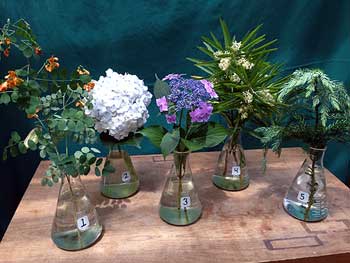August Color Appears at the Washington Park Arboretum

(August 8 – 21, 2016)
1) Clerodendrum bungei
- C. bungei is a deciduous, suckering shrub producing upright shoots and opposite, ovate, toothed, dark green leaves tinged with purple when young. Salverform, fragrant, dark pink flowers, each with five spreading lobes, are borne in rounded, terminal panicles from late summer to autumn. Native to China and a member of the family Lamiaceae, this specimen is happily spreading around the south side of bed ‘G’ on Azalea Way.
2) Fuchsia magellanica
- F. magellanica is an erect shrub with ovate-elliptic leaves, sometimes tinted red beneath. Throughout summer, it produces small flowers with red tubes, wide-spreading sepals, and purple corollas. Native to Chile and Argentina, this specimen is located within our Pacific Connections Entry Garden along the circular path.
3) Hibiscus x ‘Tosca’
- A member of the Malvaceae plant family, Hibiscus is a genus of some 200 species of trees, shrubs, and herbs – inhabitants mainly of the tropics and subtropics. This rather unspectacular specimen is located near Azalea Way, south of the large Glen Pond.
4) Sorbus ‘Birgitta’
- Sorbus is a genus of about 100 species of deciduous trees and shrubs within the family
Rosaceae. They are widely distributed throughout northern temperate regions and are
found in woodlands, on hills and mountains, and on scree. Tolerant of atmospheric pollution,
they are ideal as specimen trees in a small garden. The raw fruit may cause mild stomach upset if ingested.
5) Vitex agnus-castus and Vitex agnus-castus ‘Silver Spire’
- Another member of the family Lamiaceae, Vitex is a widespread genus of around 250
species of deciduous or evergreen shrubs occurring mainly in tropical regions and often in woodland or dry river beds. Cultivated for their elegant foliage and summer flowers, Vitex may be grown in a shrub border or against a wall. These specimens are located along Azalea Way near the Lower Woodland Pond
.